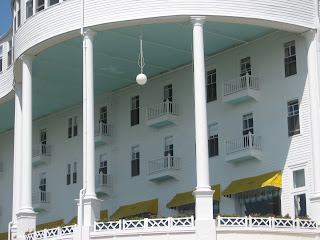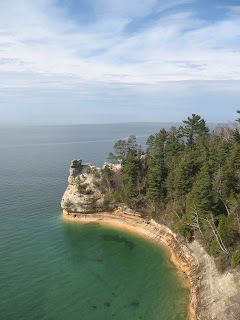Stops on the two day trip included:
- Christmas, Michigan
- Pictured Rocks
- Tahquamenon Falls State Park
- Mackinac Bridge
- Mackinac City
- Mackinac Island
- Kitchitikipi Spring
View Larger Map
CHRISTMAS MICHIGAN:
The first "stop" which was more of a passing through than a stop was Christmas, Michigan. I had seen it on the map and since it was on the way to our unknown destination (well unknown to me anyways), I asked Adam to stop for a picture.
And we hit the road again...
PICTURED ROCKS-Munising, Michigan
We then traveled an hour along the beautiful shore of Lake Superior until we arrived at Pictured Rocks. Picture Rocks is an area of lake shore along Lake Superior that extends for 42 miles. It is not actual pictures of petroglyphs but rather mineral-stained sandstone cliffs that are colored in shades of brown, tan, green, and blue by the iron, manganese, limonite and copper in the water. As the water trickles down the rocks or mountainous waves slam into the cliffs with vicious suddenness, the sandstone Pictured Rocks are formed and changed.
TAHQUAMENON FALLS STATE PARK-Paradise, Michigan
After gazing at Pictured Rocks we continued on our voyage for another two hours. Adam would not tell me where we were headed, and I did not much like waiting. We turned down a seasonal road that warned it was not plowed in winter and then passed "East-West Road"...yeah I was confused.
 |
| The "Bear Butt" a Bar and Grill we passed on our way to Tahquameon Falls Park, it was on one of the winding roads. |
The Tahquamenon Falls has two parts, the upper falls which are large and the lower falls which look more like rapids. The Tahquamenon Upper Falls is the largest waterfall east of the Mississippi, second to Niagara Falls!! It has a drop of nearly 50 feet and spans more than 200 feet across. It flows more than 50,000 gallons of water per second as recorded in 2007! I have been to Niagara Falls but I must admit these falls were pretty impressive.
The falls have a brown tint and are nicknamed "Root Beer Falls". The brown coloration is a result of Tannic Acid. Along with water, organic materials work their way into the Tahquamenon River. These materials originate from the decomposing vegetation found in the cedar, hemlock, and spruce forests found in the drainage basin. The water is not harmful to wildlife as a variety of fish call this area their home including brown trout, and walleye.
We set up camp for the night and then went to look at the lower falls. Which were not as impressive but still a sight to behold. It was sprinkling and we saw the sign of God's Promise--a rainbow, it was faint but still there.
The next morning we set out EARLY! We were on the road by 6:30am to travel another two hours to Mackinac City. Upon this travel we crossed the third largest suspension bridge in the world-The Mackinac Bridge. The Mackinac is currently the third longest suspension bridge in the world. In 1998, the Akashi Kaikyo Bridge in Japan became the longest with a total suspension of 12,826 feet. The steel superstructure will support one ton per lineal foot per roadway (northbound or southbound). All suspension bridges are designed to move to accommodate wind, change in temperature, and weight. It is possible that the deck at center span could move as much as 35 feet (east or west) due to high winds. It was fascinating to me.
 |
| Picture take from the Ferry we road to Mackinac Island. |
 |
| Driving across the bridge. |
MACKINAC ISLAND- We arrived in Mackinac City in time for the 9:00am ferry. It was a very cold, 18 minute ride on a "rooster tale" Hydro Jet ferry to the island.
Mackinac Island is famous for its lack of motorized vehicles. There are no automobiles, and the main source of transportation is bicycle or horse and buggy. Roller skates and roller blades are also allowed, except in the downtown area. Adam and I did not have bicycles but rather walked our way around the island. The island is only a mere 3.8 square miles. It contains much historical preservation and is of high importance to the previous inhabitants of the native Indians. Several historical and interesting rock formations exist on the Island as well. These include arch rock (see picture below), Devil's Kitchen (cave), Skull Cave, and Sugar Loaf. Other famous, non-natural landmarks include the Grand Hotel. The Grand Hotel has the worlds LARGEST Porch. The Grand Hotel is well known for a number of notable visitors, including five US Presidents, Russian prime minister Vladimir Putin, Russian president Dmitri Medvedev, inventor Thomas Edison, and author Mark Twain. Adam and I noticed several things about the Grand Hotel. |
 |
| View of Grand Hotel from the Ferry. |
 |
| Each room has its own balcony. |
 |
| This was all the closer Adam and I could get, as we did not have proper attire. |
 |
| Horse carriage pulling carts of luggage to the Grand Hotel. |
 |
| It costs $10.00 to enter if you are not a guest. |
 |
| Sign warning that one needs "Proper Dress" Men need suit and tie, women NOT slacks. |
There was a great deal of additional historic buildings including several churches; The Biddle House, one of the oldest structures on Mackinac Island, was built about 1780 and is interpreted in its role as a prosperous family home during the height of the fur trade in the 1820s; The Round Island Lighthouse, The Michigan Governor's Summer Residence; a Yacht Club; and Fort Mackinac.
Fort Mackinac was an American military outpost used in the late 18th century to the late 19th century. The British built the fort during the American Revolutionary War to control the strategic Straits of Mackinac between Lake Michigan and Lake Huron (and by extension the fur trade on the Great Lakes) and did not relinquish it until fifteen years after American independence. It later became the scene of two strategic battles for control of the Great Lakes during the War of 1812. During most of the 19th century, it served as an outpost of the United States Army.
KITICHITIKIPI SPRING (Big Springs)- Manistique, Michigan
The Kitichitikip Spring is Michigan's largest Spring. It is two hundred feet across and forty feet deep. It gushes 10,000 gallons of water a minute. The spring continues throughout the year at a constant 45 degrees Fahrenheit. We were able to go out on a raft and look down the crystal clear water. The raft is attached to a long cable and is powered by tourists as you turn the pulley wheel attached to the cable. Pictures did not do justice so I took a video, the video does not even capture the amazing spring. It was one of my favorite parts of the trip. I could not see water actually gushing in but we could see the sand forty feet below us "dancing". Check it out!
| |||




























